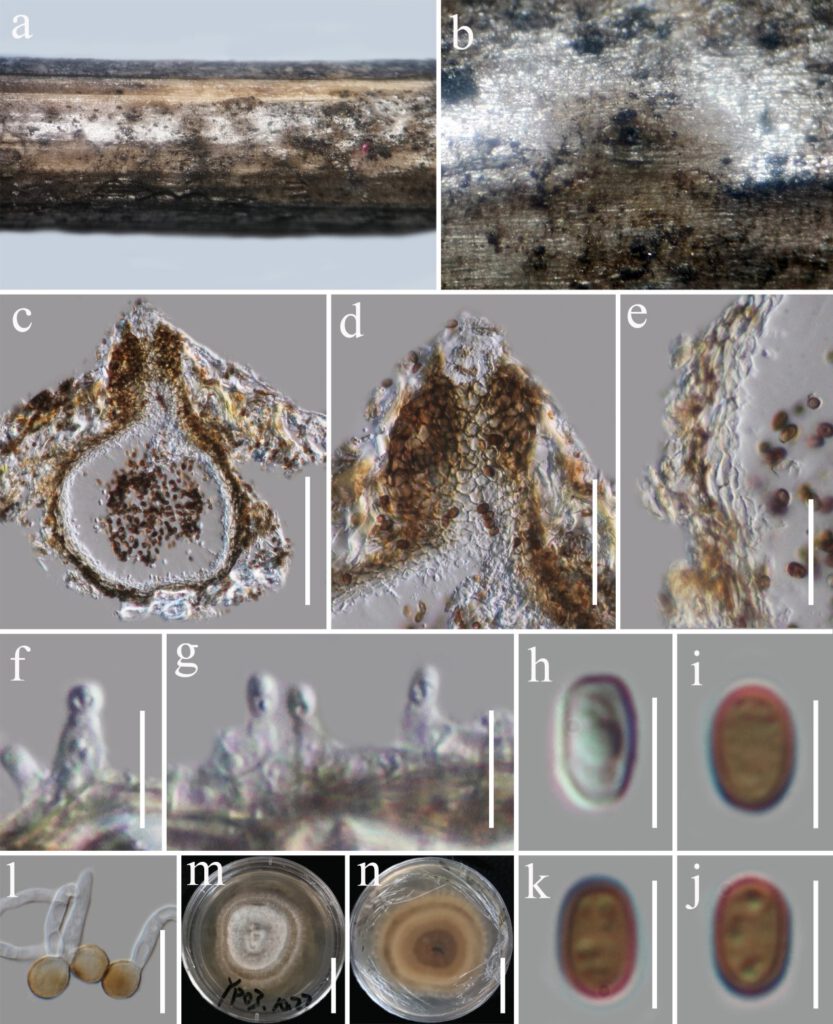Austropleospora archidendri (Verkley, Göker & Stielow) Ariyaw. & K.D. Hyde Fungal Diversity: [38] (2015) Fig. 3
= Paraconiothyrium archidendri V Verkley, Göker & Stielow, Persoonia 32: 37 (2014).
MycoBank number: MB 551419; Index Fungorum number: IF 551419; Facesoffungi number: FoF 00936;
Saprobic on dead woody twigs of Euphoria longana. Sexual morph: unknown. Asexual morph: Coelomycetous. Conidiomata 160–220 µm high × 120–160 µm diam. (x̅ = 190 × 140 µm, n = 5), scattered, immersed, unilocular, coriaceous, globose to subglobose, brown to dark-brown with central ostioles. Ostioles 60–75 × 40–50 μm (x̅ = 70 × 45 μm, n = 5), short papillate, black. Conidiomatal wall 16–24 µm thick, 3–4 layered, composed of brown outer layers and hyaline inner layers, thin-walled cells of textura angularis. Conidiophores reduced to conidiogenous cells. Conidiogenous cells 3.7–6 × 2.8–3.8 μm (x̅ = 4.2 × 3.4 μm, n = 10), enteroblastic, phialidic, determinate, discrete, doliiform to ampulliform, hyaline, smooth-walled, arising from stratum. Conidia 4.8–5.8 × 3.0–3.6 μm (x̅ = 5.4 × 3.4 μm, n = 30), straight, initially hyaline, becoming brown at maturity, subglobose to ovate, one-celled, rounded ends, thick-walled, verruculose.
Culture Characters ‒ Colonies reached 70–80 mm diam. on PDA media at 14 days at room temperature (25–30 ℃), superficial, flat, circular, medium dense, rough, fluffy, zonate raised between margin and center, gray at the margin, white at the center; reverse, zonate, pale gray at the margin and between zonate and center, dark gray at the center and zonate.
Known distribution ‒ on leaf spot in Archidendron bigeminum (Myanmar), decaying pod of Leucaena sp. (Thailand), dead woody twigs of Euphoria longana (Thailand).
Material examined ‒ Thailand, Chiang Mai Province, Yang Piang Omkoi, on dead woody twigs of Euphoria longana, 25 August 2019, G.C. Ren, YP03 (KUN-HKAS 122788), living culture KUMCC 21-0680.
Notes ‒ Austropleospora archidendri was introduced by Ariyawansa et al. (2015a) based on the combined phylogeny of LSU, SSU, β-tubulin, and ITS sequence data. Austropleospora archidendri was previously known as Paraconiothyrium archidendri. In the present study, a multigene phylogeny indicates that our strain of Austropleospora archidendri (KUMCC 21-0680) formed a sister clade with A. archidendri (MFLUCC 17-2429) with strong support (99% ML, 0.95 PP; Fig. 1). Morphologically, our strain (KUMCC KUMCC 21-0680) is similar to Austropleospora archidendri (CBS 168.77, MFLUCC 17-2429) in having doliiform conidiogenous cells and subglobose to ovate, brown aseptate conidia (Verkley et al. 2014, Jayasiri et al. 2019). Austropleospora archidendri has been reported as a pathogen on Archidendron bigeminum leaf from Thailand and as a saprobe on Leucaena sp. pod from Myanmar (Verkley et al. 2014, Jayasiri et al. 2019). Therefore, we report our strain KUMCC 21-0680 as a new record of A. archidendri saprobic on the woody litter of Euphoria longana in Thailand.

Figure 3 ‒ Austropleospora archidendri (KUN-HKAS 122788). a, b Conidiomata on the natural wood surface. c Sections through conidiomata. d Ostiolar neck. e Conidioma wall. f–g Conidiogenous cells and developing conidia. h–k Conidia. l Germinated conidium. m–n Culture characters on PDA. Scale bars: c = 100 μm, d = 50 μm, e = 25 μm, f, g, l = 10 μm, h–k = 5 μm, m–n = 30 mm.
